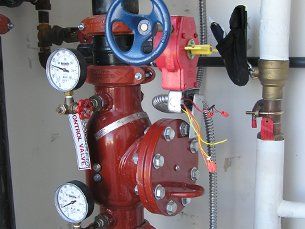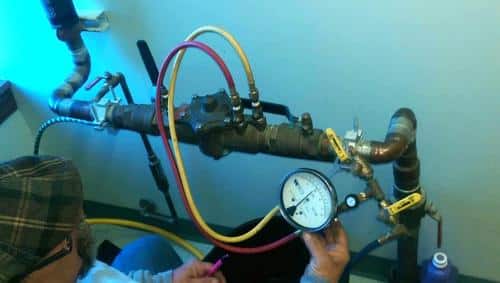Do I Have to Backflow Test My Water
Do I Have to Backflow Test My Water
Blog Article
We've unearthed the article on What is Backflow Testing? directly below on the web and figured it made perfect sense to talk about it with you on this site.

Yes, you require to backflow test your house's water supply to ensure that the water is devoid of contaminants and also unsafe degrees of chemicals. Because of the tools needed and area for error, you should not try to carry out heartburn testing by yourself. We suggest that you call a specialist plumber every couple of years to evaluate your water.
What is Heartburn?
In short, backflow is when water moves upwards-- the opposite direction in the plumbing system. This is also referred to as "backpressure." When the water moves in this instructions, it can mix with unsafe toxins and present a risk.
What Creates Heartburn?
A common cause of heartburn is a loss of water pressure that creates the water to siphon back right into the water supply. An instance is cleaning out a paint bucket using a hose. You fill up the paint pail up with water, leaving the tube in the container. After a long time, there is a loss in water pressure and also the pipe begins to draw the water back into the water supply. As you can picture, there are currently chemicals from the paint that are going into the water supply, possibly posing a danger. Sadly, many individuals are not even knowledgeable about backflow testing, yet there are many reasons it's so important.
Heartburn Screening is Required by Legislation in Certain Cities
Depending on where you live, you might really be called for by legislation to backflow test your regulation. Iowa City keeps a record of all buildings served by the city's water supply. The city calls for that certain "high-hazard" centers undergo heartburn screening. Sometimes, properties such as homes as well as apartment are impacted.
You Can Protect Against Heartburn
The primary objective of a heartburn device is to stop water from moving backward into your water supply. Plumbing technicians mount the tool on the pipelines in your home to make sure that the water only flows in the correct direction.
Heartburn Can Influence Both You as well as Your City
Numerous cities establish heartburn standards since dangerous heartburn can impact the general public water in addition to a single structure. Thankfully, modern cities have backflow tools in place that protect the supply of water that originates from the majority of residences and also industrial residential properties. The real hazard comes from watering systems, which can damage the water with poisonous plant foods, manure, and other chemicals.
Call a Plumber to Evaluate for Backflow Before It is Too Late
While it may seem grim, polluted water can cause dreadful microbial and also viral infections that are hard to deal with. A plumbing business can swiftly evaluate your home's water to identify if there are any dangerous chemical degrees. The small financial investment is if you can prevent the misery that originates from drinking infected water. And also if you do find that your water has high degrees of toxic substances, a plumber can conveniently set up a backflow avoidance tool.
Yes, you need to backflow test your home's water supply to ensure that the water is totally free of toxins and hazardous levels of chemicals. A typical reason of heartburn is a loss of water pressure that causes the water to siphon back right into the water supply. After some time, there is a loss in water stress and the tube starts to suck the water back right into the water supply. The primary purpose of a heartburn device is to protect against water from streaming backward right into your water supply. Numerous cities develop backflow standards because unsafe backflow can impact the public water supply in enhancement to a solitary structure.
Why You Need Backflow Testing
Backflow Testing
How important is it to keep your potable water and wastewater separate? The consequences of wastewater contamination can be severe, leading to numerous diseases and public health hazards. It’s important for the health of your family that you keep your plumbing in good condition and safe from the dangers of backflow.
The drinking water in your plumbing is pressurized, but the wastewater is not; it instead moves through gravity and ventilation. The design of plumbing, with different pressure areas, is what prevents cross-contamination between wastewater and potable water. A drop in water pressure can cause wastewater to flow into the potable water pipes through back-pressure. A plumber can install a backflow preventer at a strategic point to prevent this from occurring. There are other sources for backflow trouble: any faulty cross-connections—such as bypasses, jumper connections, or change-over devices—can lead to backflow.
Backflow testing is an important procedure to discover out how best to prevent contamination in your water supply. A proper test can identify the type and location of backflow preventer to help keep your fresh water clean. After a backflow preventer is installed, you should still schedule yearly testing to see that the device is working correctly.
Testing is a basic procedure for professionals: they connect a testing kit to the backflow preventer, shut off the water downstream from the device, and check that the preventer is working correctly. Because the backflow preventer is installed outside your house, you do not need to be home for the test.
https://www.tuckersac.com/blog/plumbing-service/why-you-need-backflow-testing/

As an avid reader about Is backflow testing necessary?, I figured sharing that excerpt was worthwhile. Are you aware of another individual who is inquisitive about the topic? Be sure share it. Thanks so much for taking the time to read it.
We've got you! Report this page